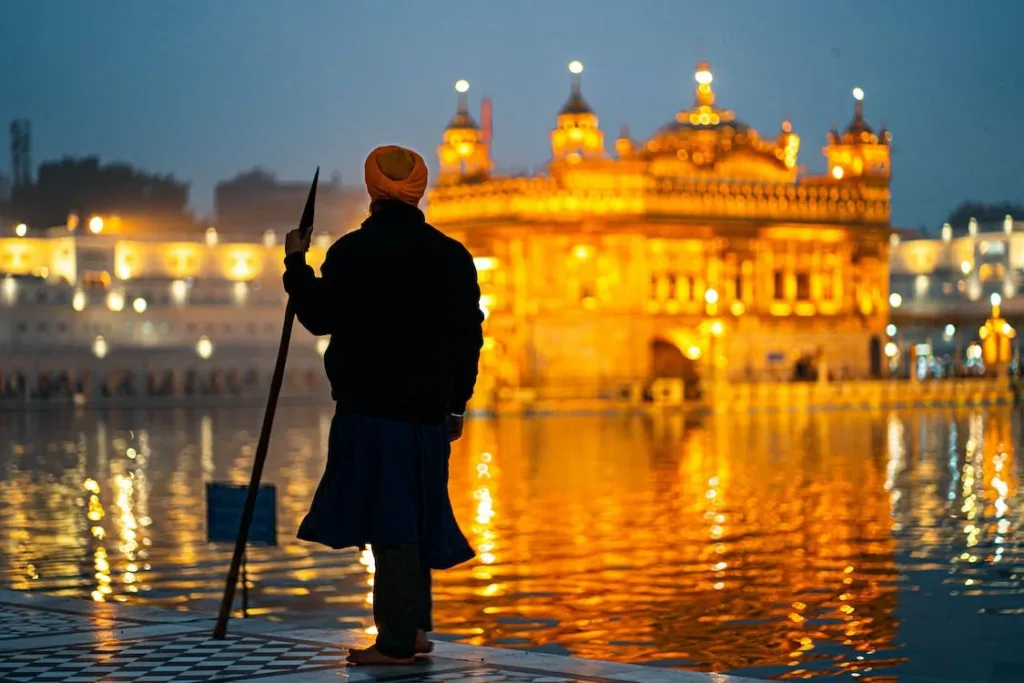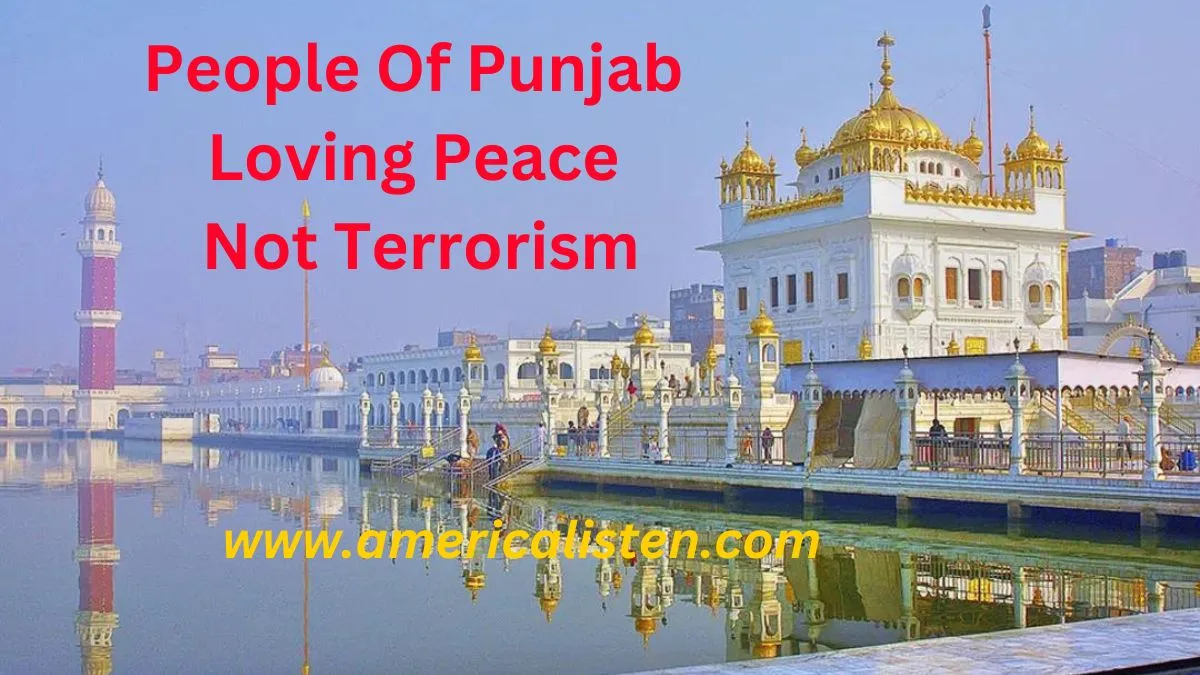Punjab, the land of five rivers, has a rich cultural and historical heritage deeply rooted in the teachings of Sikhism, Sufism, and various other traditions. Despite periods of unrest and violence, the people of Punjab have consistently demonstrated their unwavering commitment to peace, harmony, and coexistence. This article sheds light on the resolute stance of the Punjabi people against terrorism and violence.

A Legacy of Peaceful Coexistence
Punjab has long been known as a region where diverse communities have coexisted in harmony. This legacy of peaceful coexistence is exemplified by the teachings of Sikh gurus, particularly Guru Nanak Dev Ji, who preached the message of love, compassion, and equality for all. These teachings have had a profound influence on the Sikh community and the entire Punjab region.
Sufi saints like Baba Farid, Bulleh Shah, and others have also played a crucial role in fostering an atmosphere of tolerance, spirituality, and communal harmony in Punjab. Their poetry and teachings emphasize the unity of all humanity and the importance of respecting different faiths.
Rejecting Terrorism and Violence
The people of Punjab have consistently rejected terrorism and violence as a means of achieving any goal. The turbulent period of the 1980s and early 1990s witnessed the rise of militant Sikh separatist groups advocating for Khalistan, an independent Sikh state. While these groups attracted attention, they did not enjoy widespread support among the Punjabi population.
In fact, the overwhelming majority of Punjabis rejected violence and terrorism, recognizing that such actions only bring suffering and chaos to their beloved land. The events of Operation Blue Star in 1984 and the subsequent anti-Sikh riots were painful chapters in Punjab’s history. However, these dark moments did not sway the Punjabi people from their commitment to peace and justice.
Contributions to National Security
Punjab has made significant contributions to India’s national security. The state has produced brave soldiers, officers, and police personnel who have defended the nation against external threats and internal challenges. These individuals have displayed exceptional valor and commitment to upholding the law, maintaining order, and safeguarding the unity of the country.
The Role of Civil Society
Civil society organizations, religious institutions, and community leaders in Punjab have played a pivotal role in promoting peace and communal harmony. They have worked tirelessly to bridge gaps, foster interfaith dialogue, and ensure that the younger generation is raised with values of tolerance, respect, and non-violence.

The people of Punjab stand as a shining example of resilience and commitment to peace. Despite challenges and turbulent times in the region’s history, they have consistently upheld the values of Sikhism, Sufism, and other spiritual traditions that emphasize love, compassion, and unity. Their unwavering rejection of terrorism and violence serves as a testament to the enduring spirit of Punjab, a land where people of all backgrounds live together in harmony and contribute to the rich tapestry of India’s cultural diversity.
Lessons from the Eighties: Punjab’s Resolute Stance Against Violence
The state of Punjab, often referred to as the “Land of Five Rivers,” has witnessed its fair share of challenges and turmoil, particularly during the turbulent period of the 1980s. This era marked a dark chapter in Punjab’s history, characterized by terrorism and violence. However, the people of Punjab emerged from those trying times having learned valuable lessons, which have led them to vehemently reject any form of violence. This article explores how the people of Punjab have embraced peace and harmony in the aftermath of the violence that plagued their land.
The Turbulent Eighties
The 1980s were a period of great turmoil for Punjab, primarily due to the rise of militant Sikh separatist movements advocating for Khalistan, an independent Sikh state. The state bore witness to acts of terrorism, militancy, and violence, which left scars that would not easily fade. Operation Blue Star in 1984, which aimed to remove militants from the Golden Temple in Amritsar, and the subsequent anti-Sikh riots that erupted after the assassination of Prime Minister Indira Gandhi were deeply traumatic events.
Lessons Learned
While the turbulence of the 1980s left an indelible mark on Punjab, it also served as a crucible for learning valuable lessons. The people of Punjab, who had historically espoused the teachings of Sikh gurus emphasizing peace, compassion, and communal harmony, were reminded of the enduring importance of these principles.
Unity in Diversity: Punjab has a diverse religious and cultural landscape, with Sikhs, Hindus, and Muslims coexisting for centuries. The violence of the 1980s taught the people of Punjab the significance of unity in diversity. It underscored the need to embrace the rich tapestry of cultures and traditions that make Punjab a unique and vibrant place.
Rejecting Violence: The horrors of terrorism and militancy in the eighties showed the devastating consequences of violence. Families were torn apart, communities shattered, and innocent lives lost. Punjab’s people realized that violence only begets more violence and opted to shun it vehemently.
Rebuilding Trust: The aftermath of the turbulent period presented the people of Punjab with the monumental task of rebuilding trust among communities. Efforts toward reconciliation and communal harmony became paramount, and organizations and leaders worked tirelessly to heal wounds and foster unity.
The Resolute Stance Against Violence
Today, the people of Punjab stand united in their resolute rejection of any form of violence. The scars of the past have instilled in them a deep appreciation for the value of peace and harmony. Punjab’s civil society, religious institutions, and community leaders have played a pivotal role in promoting dialogue, tolerance, and the rejection of extremism.
Punjab’s contribution to India’s national security, through the brave soldiers and police personnel it has produced, is a testament to its commitment to upholding the law and maintaining peace and order.
Conclusion
The people of Punjab have emerged from the shadows of violence in the 1980s stronger and more determined than ever to protect the values of peace, compassion, and communal harmony. They have learned valuable lessons from the past and are dedicated to building a prosperous and peaceful future for their beloved state. Punjab’s resolute stance against violence serves as a powerful reminder that even in the face of adversity, the enduring principles of peace and unity will always prevail.
DO You Know?
Question: Who played a crucial role in removing terrorism from Punjab?
Answer: The removal of terrorism from Punjab was a collaborative effort involving multiple stakeholders, including the Indian government and its security forces, as well as the people of Punjab themselves.
Question: When did terrorism end in Punjab?
Answer: Terrorism in Punjab saw significant reductions in the mid-1990s. On August 31, 1995, Chief Minister Beant Singh was killed by a suicide bomber, which marked a turning point. While violence persisted in some pockets for a while, this event marked a significant shift towards peace.
Question: What is the name of Sikh terrorism?
Answer: Sikh terrorism was primarily associated with organizations like “Babbar Khalsa International” (BKI), which aimed to establish an independent Sikh state called Khalistan in Punjab. BKI engaged in armed attacks, assassinations, and bombings.
Question: What would happen if Khalistan is made?
Answer: The creation of Khalistan would have significant consequences, including the potential partition of the state of Punjab. However, it’s crucial to note that this remains a hypothetical scenario, and the complexities of such a situation would have far-reaching implications for the region.
Question: Who started the Khalistan movement?
Answer: The modern Khalistan movement can trace its origins to around the time of India’s independence from Britain in 1947. Jagjit Singh Chohan was a prominent leader who sought to create a sovereign Sikh state in the Punjab region of the Indian subcontinent.
Question: How many Sikhs died in the war?
Answer: During the two World Wars, approximately 83,005 Sikh soldiers were killed, and 109,045 were wounded while serving in the armed forces. They made significant sacrifices for the freedom of Britain and the world.
Question: How many Muslims were killed in Punjab during partition?
Answer: During the partition of India in 1947, it is estimated that around one million people were killed, and over ten million people crossed the border. Muslims migrated from East Punjab (in India) to West Punjab (in Pakistan), and Hindus and Sikhs migrated from West Pakistan to East Pakistan (now Bangladesh).
Question: Is Babbar Khalsa banned in Canada?
Answer: Yes, Babbar Khalsa International (BKI) is banned and designated as an international terrorist organization by several countries, including the United States, Canada, the United Kingdom, the European Union, Japan, Malaysia, and India.
Question: Is the Khalistan movement active again?
Answer: While the Khalistan movement saw a decline in the 1990s, there have been signs of its resurgence since 2015. This second wave of the movement has received support from a more influential Sikh diaspora and includes organizations like “Sikhs For Justice” (SFJ) and the “Poetic Justice Foundation” (PJF), among others.
Question: Who supported the Khalistan movement?
Answer: During the insurgency in Punjab, there were allegations of material support provided to Khalistani militants by Pakistan and China. These allegations pointed to the involvement of these countries in supporting the movement.
Question: Does Sikhism support Khalistan?
Answer: Sikhism, as a religion, does not inherently support the creation of Khalistan. The Khalistan movement is a political and separatist movement, and its objectives are distinct from the religious teachings of Sikhism. While some individuals within the Sikh community may support Khalistan, it is not universally endorsed by Sikhs.
Question: How many Hindus died in Khalistan?
Answer: The Khalistan movement, during its peak in the 1980s and 1990s, resulted in violence that claimed the lives of both Sikhs and Hindus. It is estimated that nearly 22,000 individuals, including civilians, lost their lives during this period.
Question: How many Hindus are there in Punjab?
Answer: According to the Census of Punjab in 2021, the population of Punjab consists of approximately 38.49 percent Hindus, 57.69 percent Sikhs, 1.93 percent Muslims, and 1.26 percent Christians.
Question: Are there any Sikhs in Pakistan?
Answer: Yes, there is a Sikh community in Pakistan, primarily residing in the province of Punjab. While their numbers are relatively small today, Pakistan has a historical and cultural connection to Sikhism, particularly in the region where the religion originated.
Question: Does Khalsa mean Khalistan?
Answer: No, Khalsa and Khalistan are two distinct concepts with different historical and political connotations. Khalsa refers to the initiated and baptized Sikhs who adhere to the Sikh code of conduct. Khalistan, on the other hand, represents the political idea of an independent Sikh state in Punjab.
to know more about Sikhs please click here
You May like :
Best Winter Dish: Dry Fish,Uses Medical Benefits Recipes and Side Effects


